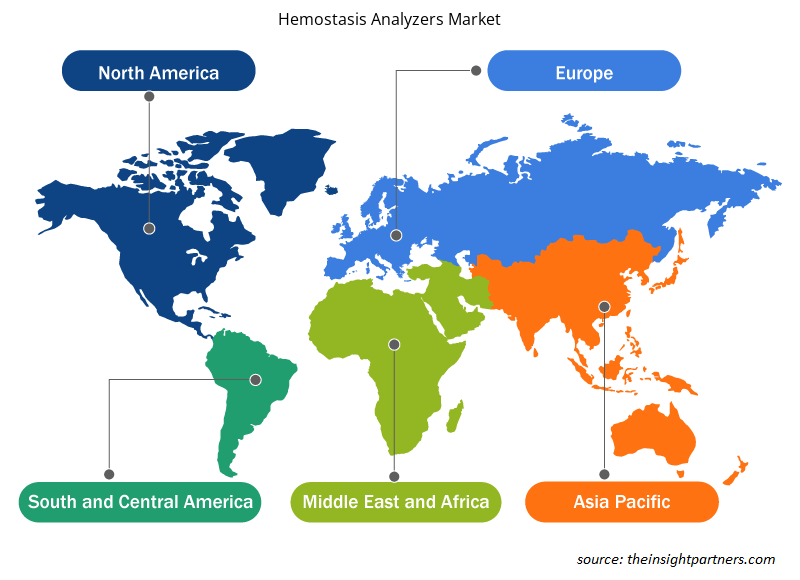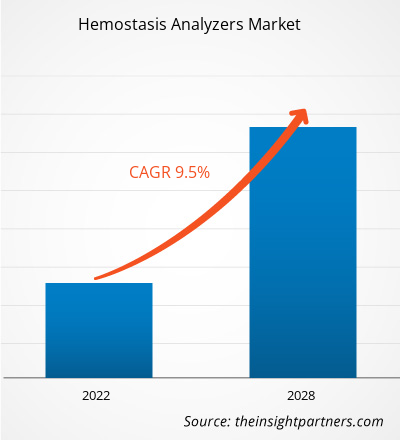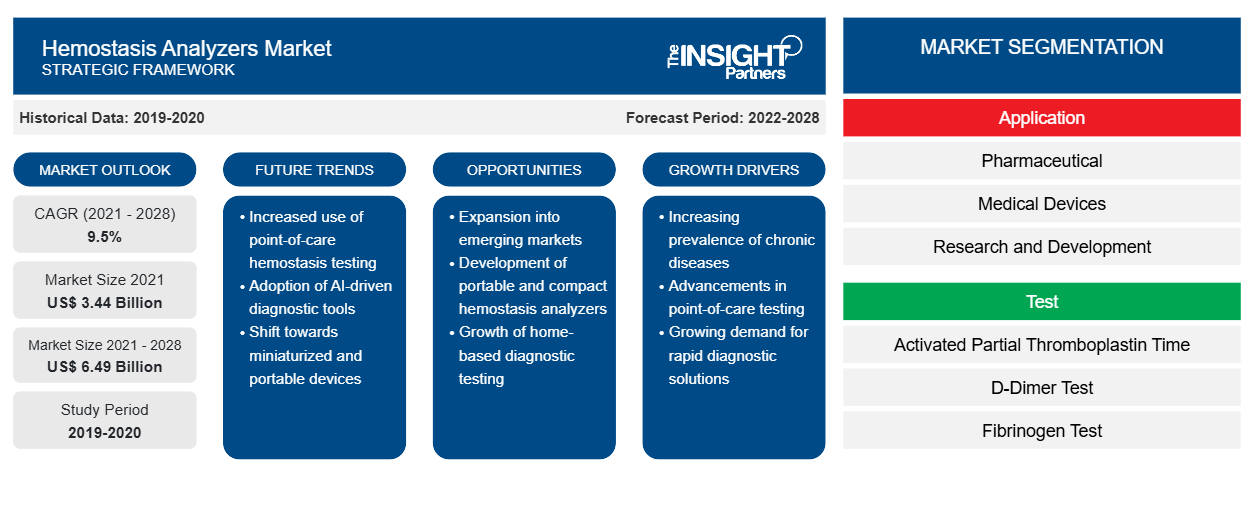Der Markt für Hämostaseanalysatoren soll von 3.440,66 Millionen US-Dollar im Jahr 2021 auf 6.490,24 Millionen US-Dollar im Jahr 2028 anwachsen; für den Zeitraum von 2021 bis 2028 wird eine durchschnittliche jährliche Wachstumsrate (CAGR) von 9,5 % erwartet.
Hämostaseanalysatoren ermöglichen eine schnelle und einfache Messung des Blutplättchenspiegels. Ein Gerinnungstest kann helfen, Blutgerinnsel zu erkennen und zu verhindern, die einen Herzinfarkt verursachen könnten. Ein Gerinnungsanalysator kann die Geschwindigkeit des Gerinnungswegs und die Mengen an Thrombolin und Thromboplastin in weniger als ein paar Minuten messen. Herz-Kreislauf-Erkrankungen (CVDs) bleiben wahrscheinlich die bedeutendste Ursache für Morbidität und Mortalität weltweit. Die CVDs sind Erkrankungen des Herzens und der Blutgefäße und umfassen zerebrovaskuläre Erkrankungen, koronare Herzkrankheiten, rheumatische Herzkrankheiten und andere Erkrankungen. Einige lebensstilbedingte Probleme, die zu Herz-Kreislauf-Erkrankungen und -Beschwerden führen, sind Tabakkonsum, ungesunde Ernährung und körperliche Inaktivität. Sie erhöhen das Risiko von Herzinfarkten und Schlaganfällen. Weitere Risikofaktoren für Herz-Kreislauf-Erkrankungen sind Bluthochdruck, Diabetes und erhöhte Cholesterinwerte. Laut der Weltgesundheitsorganisation (WHO) sind Herz-Kreislauf-Erkrankungen weltweit die häufigste Todesursache.
Passen Sie diesen Bericht Ihren Anforderungen an
Sie erhalten kostenlos individuelle Anpassungen an jedem Bericht, einschließlich Teilen dieses Berichts oder einer Analyse auf Länderebene, eines Excel-Datenpakets sowie tolle Angebote und Rabatte für Start-ups und Universitäten.
- Holen Sie sich die wichtigsten Markttrends aus diesem Bericht.Dieses KOSTENLOSE Beispiel umfasst eine Datenanalyse von Markttrends bis hin zu Schätzungen und Prognosen.
Markteinblicke:
Anstieg der geriatrischen Bevölkerung treibt den Markt für Hämostaseanalysatoren an
Ältere Menschen sind aufgrund schwacher Immunität und anderer gesundheitlicher Probleme anfällig für Herzkrankheiten. Allgemeine Alterungsfaktoren führen zu einer Versteifung des Herzens und der Blutgefäße, was zu Herzerkrankungen führt. Mit zunehmendem Alter steigt auch der systolische Blutdruck, was zu Herz-Kreislauf-Erkrankungen (CVDs) führt. Daher ist Bluthochdruck bei Menschen ab 75 Jahren ein häufiger Risikofaktor für Herzkrankheiten. Koronare Herzkrankheit und Herzinsuffizienz sind die anderen. Obwohl die Häufigkeit von Herzrhythmusstörungen Menschen aller Altersgruppen betrifft, steigt sie bei der geriatrischen Bevölkerung erheblich an.
Laut der Studie „Global Ageing 2019“ betrug die Weltbevölkerung im Jahr 2019 703 Millionen Menschen im Alter von 65 Jahren und älter. Bis 2050 wird sich diese demografische Gruppe voraussichtlich auf 1,5 Milliarden Menschen verdoppeln. Die Häufigkeit, mit der eine Person über 65 Jahre alt ist, wird voraussichtlich von 1 von 11 Einwohnern im Jahr 2019 auf 1 von 6 Einwohnern bis 2025 steigen. Diese demografische Gruppe ist anfälliger für Herz-Kreislauf-Erkrankungen wie Herzrhythmusstörungen. Und laut der Weltgesundheitsorganisation (WHO) wird der Anteil der Menschen im Alter von 60 Jahren und älter von 12 % im Jahr 2015 auf 22 % bis 2050 ansteigen. Laut dem Bericht „Older Americans 2016: Key Indicators of Well-Being“ des Federal Interagency Forum on Aging-Related Statistics hatten 35,8 % der Personen im Alter von 85 Jahren und älter eine leichte oder schwere kognitive Störung. Darüber hinaus waren laut dem Bericht der Vereinten Nationen zur Alterung der Weltbevölkerung 2017 weltweit 962 Millionen Menschen 60 Jahre oder älter, und diese Zahl wird bis 2050 voraussichtlich auf fast 2,1 Milliarden ansteigen.
Die ältere Bevölkerung ist anfälliger für atypische Krankheitsbilder, Begleiterkrankungen und ungünstige Folgen. Der Hauptgrund für die Krankheiten sind die strukturellen und funktionellen Veränderungen des Herz-Kreislauf-Systems, die mit dem Altern einhergehen. Der Anstieg der geriatrischen Bevölkerung weltweit führt zu einem Anstieg der Herz-Kreislauf-Erkrankungen, was wiederum die Nachfrage nach Hämostase-Analysegeräten ankurbelt.
Produkttypbasierte Einblicke
Basierend auf dem Produkttyp ist der Markt für Hämostaseanalysatoren weiter in Laboranalysatoren und Point-of-Care-Testsysteme unterteilt . Im Jahr 2021 hält das Segment der Laboranalysatoren den größten Marktanteil, und das Segment der Point-of-Care-Testsysteme dürfte im Zeitraum 2021–2028 die höchste durchschnittliche jährliche Wachstumsrate verzeichnen.
Marktanteil von Hämostaseanalysatoren nach Produkttyp – 2021 und 2028
Testbasierte Erkenntnisse
Basierend auf Tests ist der Markt in aktivierte partielle Thromboplastinzeit, D-Dimer-Test, Fibrinogentest, Prothrombinzeittest und andere unterteilt. Im Jahr 2021 hatte das Segment der aktivierten partiellen Thromboplastinzeit den größten Marktanteil. Das Segment der Prothrombinzeittests wird voraussichtlich zwischen 2021 und 2028 die höchste durchschnittliche jährliche Wachstumsrate auf dem Markt verzeichnen.
Endbenutzerbasierte Erkenntnisse
Based on end users, the market is segmented into hospitals/clinics, independent diagnostic laboratories, home care settings, and others. In 2021, the hospitals/clinics segment accounted for the largest share of the market. The independent diagnostic laboratories segment is expected to register the highest CAGR in the market during 2021–2028.
Companies operating in the hemostasis analyzers market emphasize adopting the strategy of product innovations to meet the evolving customer demands worldwide, which also permits them to maintain their brand name in the global market.
Hemostasis Analyzers Market – Segmentation
The Hemostasis Analyzers market is segmented based on product type, test, and end-user. Based on product type, the hemostasis analyzers market is segmented into laboratory analyzers and point-of-care testing systems. Based on test, the market is further segmented into activated partial thromboplastin time, D-Dimer test, fibrinogen test, prothrombin time test, and others. Based on end-user, the market is segmented into hospitals/clinics, independent diagnostic laboratories, home care settings, and others. In terms of geography, the hemostasis analyzers market is segmented into North America (the US, Canada, and Mexico), Europe (France, Germany, Italy, the UK, Spain, and the Rest of Europe), Asia Pacific (Australia, China, India, Japan, South Korea, and the Rest of APAC), the Middle East & Africa (Saudi Arabia, South Africa, the UAE, and the Rest of MEA), and South and Central America (Brazil, Argentina, and the Rest of SCAM)
Hemostasis Analyzers Market Regional Insights
The regional trends and factors influencing the Hemostasis Analyzers Market throughout the forecast period have been thoroughly explained by the analysts at Insight Partners. This section also discusses Hemostasis Analyzers Market segments and geography across North America, Europe, Asia Pacific, Middle East and Africa, and South and Central America.

- Get the Regional Specific Data for Hemostasis Analyzers Market
Hemostasis Analyzers Market Report Scope
| Report Attribute | Details |
|---|---|
| Market size in 2021 | US$ 3.44 Billion |
| Market Size by 2028 | US$ 6.49 Billion |
| Global CAGR (2021 - 2028) | 9.5% |
| Historical Data | 2019-2020 |
| Forecast period | 2022-2028 |
| Segments Covered | By Application
|
| Regions and Countries Covered | North America
|
| Market leaders and key company profiles |
|
Marktteilnehmerdichte: Der Einfluss auf die Geschäftsdynamik
Der Markt für Hämostaseanalysatoren wächst rasant, angetrieben durch die steigende Nachfrage der Endnutzer aufgrund von Faktoren wie sich entwickelnden Verbraucherpräferenzen, technologischen Fortschritten und einem größeren Bewusstsein für die Vorteile des Produkts. Mit steigender Nachfrage erweitern Unternehmen ihr Angebot, entwickeln Innovationen, um die Bedürfnisse der Verbraucher zu erfüllen, und nutzen neue Trends, was das Marktwachstum weiter ankurbelt.
Die Marktteilnehmerdichte bezieht sich auf die Verteilung der Firmen oder Unternehmen, die in einem bestimmten Markt oder einer bestimmten Branche tätig sind. Sie gibt an, wie viele Wettbewerber (Marktteilnehmer) in einem bestimmten Marktraum im Verhältnis zu seiner Größe oder seinem gesamten Marktwert präsent sind.
Die wichtigsten auf dem Markt für Hämostaseanalysatoren tätigen Unternehmen sind:
- Siemens AG
- Instrumentierungslabor
- Abbott
- Sysmex Corporation
- Nihon Kohden Corporation
Haftungsausschluss : Die oben aufgeführten Unternehmen sind nicht in einer bestimmten Reihenfolge aufgeführt.

- Überblick über die wichtigsten Akteure auf dem Markt für Hämostaseanalysatoren
Firmenprofile
- Siemens AG
- Instrumentierungslabor
- Abbott
- Sysmex Corporation
- Nihon Kohden Corporation
- Thermo Fisher Scientific Inc.
- Roche Diagnostics
- Diagnostica Stago
- Helena Laboratories
- Internationale Technidyne Corporation.
- Historische Analyse (2 Jahre), Basisjahr, Prognose (7 Jahre) mit CAGR
- PEST- und SWOT-Analyse
- Marktgröße Wert/Volumen – Global, Regional, Land
- Branchen- und Wettbewerbslandschaft
- Excel-Datensatz
Aktuelle Berichte
Erfahrungsberichte
Grund zum Kauf
- Fundierte Entscheidungsfindung
- Marktdynamik verstehen
- Wettbewerbsanalyse
- Kundeneinblicke
- Marktprognosen
- Risikominimierung
- Strategische Planung
- Investitionsbegründung
- Identifizierung neuer Märkte
- Verbesserung von Marketingstrategien
- Steigerung der Betriebseffizienz
- Anpassung an regulatorische Trends





















 Kostenlose Probe anfordern für - Markt für Hämostaseanalysatoren
Kostenlose Probe anfordern für - Markt für Hämostaseanalysatoren